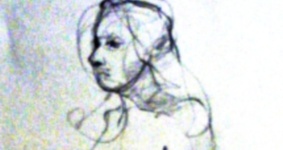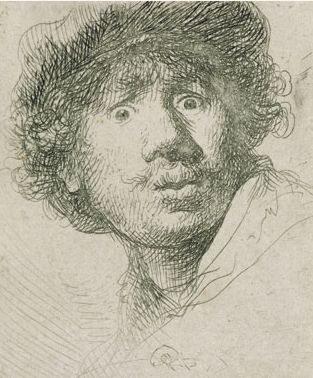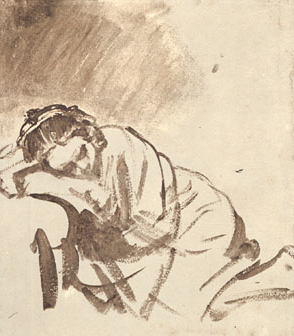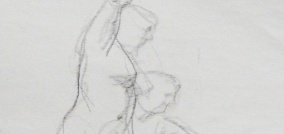
by Bob Martin | Jan 27, 2024 | Art, Creativity, Drawing, Education
(Originally posted 8/13/09)
This week I participated in another sketch class and struck up a conversation with a couple of the artists about how different artists have a philosophy about or an approach to life drawing, painting, music etc and that it is important, regardless of what artistic discipline you are involved with, that you find and be comfortable with your own “voice”. In many aspects of our daily lives, we compromise ourselves so that we can fit in at work, school and maybe even family, however being creative is about not fitting in. The term self expression is not meant to mean “our expression”.

Tony Ryder

Egon Schiele
So I’ve always cautioned artists (myself included) in avoiding mimicking or embeding
themselves totally in the philosophy of other artists. Here are some drawings from artists who’s work I admire – yet they are very different from each other and from my own drawings.
The keywords are “Self Expression”

Bob Martin
~~ ** ~~

by Bob Martin | Aug 6, 2023 | Art, Drawing
Sketching in general entails 4 distinct steps: line, tone, texture, and shape. In the special case of pencil portrait drawing we can refine the list of steps to six: shape, proportion, anatomy, texture, tone, and planes.
Sketching in general entails 4 distinct steps: line, tone, texture, and shape. In the special case of pencil portrait drawing we can refine the list of steps to six: shape, proportion, anatomy, texture, tone, and planes.
In this article we will give a detailed description of each of those pencil portrait drawing steps.
(1) Form Shape or Shape – The illusion of three-dimensionality in sketching and art in general has been central to Western art for centuries. The carving out of shape using line, structure, and tone was vital to almost all Renaissance art.
On the other hand, oriental and much contemporary art stress flatness of shape although this era in contemporary art is drawing to a close.
All shape in sketching can be reduced to 4 basic 3-dimensional solids: bricks, cones, cylinders, and spheres. The correct use of these shapes together with perspective and tone leads to the illusion of 3-dimensionality even though the drawing is, in reality, located on a two-dimensional sheet of sketching paper.
In portrait sketching, the arabesque of the skull, the square structure of the skull, and all elements within the skull (nose, eyes, etc.) are all two- and 3-dimensional shapes that contribute to the overall illusion of 3-dimensionality
(2) Proportion – encompasses all sizing and placements of shape. Proportion refers to the concept of relative length and angle size.
Proportion gives answers to these two questions:
1. Given a defined unit of length, how many units is a particular length?
2. How large is this particular angle?
Answering these 2 questions consistently accurately will yield a drawing with the right proportions and placements of all shapes.
(3) Anatomy – refers essentially to the underlying structures of bone and muscle of the skull.
It is essential to study as much as you can about anatomy. There are a lot of studies available on anatomy for artists. For a portrait artist it is particularly significant to understand the anatomy of the skull, neck, and shoulders.
Anatomy studies unfortunately include many Latin terms which makes it somewhat complicated to grasp. The idea is to study slowly and a little bit at a time because it can be quite frustrating.
 (4) Texture – in portrait sketching expresses the degree of roughness or smoothness of the shapes. The texture of a concrete walk way, for instance, is quite different from that of a cloud.
(4) Texture – in portrait sketching expresses the degree of roughness or smoothness of the shapes. The texture of a concrete walk way, for instance, is quite different from that of a cloud.
There are quite a few techniques and tricks to assist you with the creation of the correct textures. Creating textures gives you the chance to be very creative and to use each possible type of mark you can make with a pencil. In portrait sketching textures occur in spots such as hair, clothing, and skin.
(5) Tone – refers to the degrees in light or dark of the pencil marks and cross-hatchings. Powerful portrait sketches employ the full range of contrasting lights and darks. Beginning artists many times fail to achieve this full “stretch” of tone, resulting in retiring, washed-out drawings.
(6) Planes – create the sculptural sensibility of a portrait. The skull has many planes each with a unique direction and therefore with a different tone.
The idea is to think of the surface of the skull as a collection of distinct planes with a certain direction relative to the light source. You should try to identify each of the planes and draw its correct form and tone.
The correct handling of planes contributes a lot to the likeness of your model as well as the illusion of 3-dimensionality.
(Originally posted Jan 2, 2021)
Do you want to learn the secrets of pencil portrait drawing? Download my brand new free pencil portrait drawing course here: portrait drawing tutorial.
Remi Engels is a pencil portrait artist and oil painter and expert drawing teacher. See his work at pencil portraits by Remi.
P.S. For the fancy art of the 21st century and video games – visit buy PlayStation 3 info blog.
[ad#reviewpost]
~ / ~
by Sandy | Feb 7, 2018 | Art, Arts, Entertainment and Music, Blogroll, Drawing, Museums
 In the show, Toyin Ojih Odutola: To Wander Determined, the artist “creates intimate drawings that explore the complexity and malleability of identity…Rendered life-size in charcoal, pastel, and pencil, Ojih Odutola’s figures appear enigmatic and mysterious, set against luxurious backdrops of domesticity and leisure. “
In the show, Toyin Ojih Odutola: To Wander Determined, the artist “creates intimate drawings that explore the complexity and malleability of identity…Rendered life-size in charcoal, pastel, and pencil, Ojih Odutola’s figures appear enigmatic and mysterious, set against luxurious backdrops of domesticity and leisure. “
Toyin Ojih Odutola: To Wander Determined
Whitney Museum of American Art
Until February 25, 2018
(Image: Wall of Ambassadors, charcoal, pastel & Pencil 2017)

by Bob Martin | Apr 28, 2016 | Drawing
For untrained artists the problem of seeing lies in the inconsistency that exists between the actual visual reality of an object and the way the brain attempts to represent our perception of this reality on the drawing paper. This attempt always involves the tendency to draw our symbolic preconception instead of the actual reality.
Symbolic preconceptions are part of a subconscious visual language that uses symbols to represent known subjects. This language of symbols evolved as a mechanism to help us survive as a species. These symbols help us, for example, to instantly recognize food sources or dangerous predators.
When we view an unknown object our subconscious mind immediately tries to form a new symbol to represent and store the object in memory. Often beginning artists will more accurately draw unknown objects than familiar ones because they are not yet married to the new symbols.
However, when they try to draw the same object a second time, it is likely that a more symbolic image will emerge because ready to use symbols have already been stored in the brain.
Consider, for example, the word “head”. Immediately an image comes to mind which is symbolic for the head. Unfortunately, this symbol is only a schematic representation of a head and is invariably a gross simplification of a real head. Nevertheless, there is a strong subconscious pull to draw the symbol instead of what we actually see.
It is this conflict that artists must try to overcome. This is particularly a problem for pencil portrait artists. When drawing a portrait the artist must resolve numerous layers of symbols to achieve a realistic effect.
We now will describe a very good exercise to learn to avoid the problem of symbol drawing.
We will be drawing from an upside-down photograph. This way our symbolic preconception of the head is disrupted. We will be required to draw without our symbols. The result will be a purer drawing occurrence unfettered by a tainted perception.
As you draw the lines and block in the values you will feel quite awkward in your drawing. This is a good thing. Do not be overly concerned of how your drawing looks. This is an exercise in seeing.
When practicing line and tone this way, beginning artists often get better results than from the right-side up way. Trust yourself and throughout the exercise only look at your photograph in the upside-down position even though it may feel quite uncomfortable.
You will learn to see and draw tone as shapes and will be able to break down hard edges into short, straight lines instead of the usual symbols your brain will give to the nose, the ears, etc.
Thinking of and naming perceived objects will lead you down the garden path of almond shaped eyes, two holes for nostrils, a bunch of lines for hair, cauliflower ears and something that looks like the letter M located on a bowl for a mouth instead of what is actually there.
Artists will never be free of symbolic preconceptions. The symbols actually adapt and become more complicated. It is by constantly analyzing and abstracting form that we are able to draw realistically.
Remi Engels, Ph.D., is a pencil portrait artist and oil painter. He is also the creator of a popular Free Pencil Portrait Drawing Course. Get your free copy here: Free Pencil Portrait Course while supplies last. Also, glimpse some of Remi’s pencil portraits at Remi’s Pencil Portrait Web Site.
For the art of another kind – game art – read these PlayStation 3 pre order tips.
[ad#review-2a]
by Sandy | Nov 9, 2015 | Arts, Entertainment and Music, Blogroll, Drawing

“The representation of human emotion through facial expression has interested western artists since antiquity. Drawn from The Metropolitan Museum of Art’s collections of drawings, prints, and photographs, the diverse works in this installation, ranging from portraits and caricatures to representations of theater and war, reveal how expression underpinned narrative and provided a window onto the character and motivations of the subjects, the artists, and even their audience.“
“About Face: Human Expression on Paper”
Until December 13, 2015
The Metropolitan Museum of Art
5th Ave and 86 Street, NYC
(Image: “Medea”, ca. 1715, Charles Antoine Coypel (French, 1694–1752)
***

by Bob Martin | Aug 18, 2014 | Art, Drawing, Learning

Working quickly capturing two models in short poses is a great drill. You have to make a decision about what is important in what you are seeing and want to capture on paper. You have to think fast and draw slow. Recently I’ve gotten to work with two drawing models, this was a five minute pose.
[ad#reviewpost]
(Original post 8/28/09)












